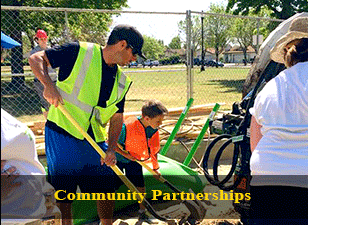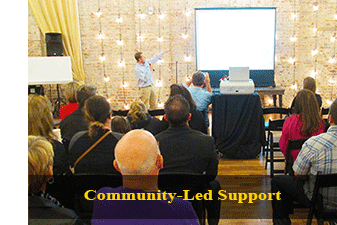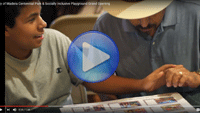Keys to Successful Public / Private Partnerships
Author: Chad Kennedy, Landscape Architect, ASLA
 The past year or two of relative stability in the Northern California economy have shed a light on just how ruthless the many years of economic turmoil in the State were. In reality, the level of devastation to local economies will continue to be felt for a very long time. With the few exceptions of newer parks, a visit to most municipal pocket, neighborhood, and community parks will reveal the depth to which local governments were impacted. An astute observer might notice the trees that haven't been pruned in years, the patchy grass that is infested with broad-leaf weeds, or the missing shrubs that were never replaced after drought conditions required water to be shut off. Another visitor might notice the perpetually closed restrooms fallen prey to vandals, the absence of tables and benches that have succumbed to disrepair, the drinking fountains that, when all the stars align, might provide trickles of water, or the playgrounds that have peeling paint and are boarded up when replacement parts aren't available and budgets won't allow for complete replacement. The devastation still being felt in the aftermath of the recent recession, masked by a fairly strong recovery, is deferred maintenance from years of neglect when no funds were earmarked for park and open space maintenance. The impact is being felt even greater at facilities funded through general fund allocations, where a maintenance fund is not available. Many communities are millions of dollars behind in basic maintenance and will struggle for years to catch up with a base line standard. Though this seems like a dire situation, many communities are stepping up to the challenge and are making good things happen despite the lemon handed to them. One method many communities have been using to combat deferred maintenance is a public / private partnership model. These models attempt to maximize the power of the citizen to raise awareness and funds through teaming with municipalities with stronger support for infrastructure, resources and stability. The following will highlight some of the necessary components and keys to an effective partnership program.
The past year or two of relative stability in the Northern California economy have shed a light on just how ruthless the many years of economic turmoil in the State were. In reality, the level of devastation to local economies will continue to be felt for a very long time. With the few exceptions of newer parks, a visit to most municipal pocket, neighborhood, and community parks will reveal the depth to which local governments were impacted. An astute observer might notice the trees that haven't been pruned in years, the patchy grass that is infested with broad-leaf weeds, or the missing shrubs that were never replaced after drought conditions required water to be shut off. Another visitor might notice the perpetually closed restrooms fallen prey to vandals, the absence of tables and benches that have succumbed to disrepair, the drinking fountains that, when all the stars align, might provide trickles of water, or the playgrounds that have peeling paint and are boarded up when replacement parts aren't available and budgets won't allow for complete replacement. The devastation still being felt in the aftermath of the recent recession, masked by a fairly strong recovery, is deferred maintenance from years of neglect when no funds were earmarked for park and open space maintenance. The impact is being felt even greater at facilities funded through general fund allocations, where a maintenance fund is not available. Many communities are millions of dollars behind in basic maintenance and will struggle for years to catch up with a base line standard. Though this seems like a dire situation, many communities are stepping up to the challenge and are making good things happen despite the lemon handed to them. One method many communities have been using to combat deferred maintenance is a public / private partnership model. These models attempt to maximize the power of the citizen to raise awareness and funds through teaming with municipalities with stronger support for infrastructure, resources and stability. The following will highlight some of the necessary components and keys to an effective partnership program.
How Partner Programs Work
Partner programs start with the community. Their success is contingent on citizens expressing interest in developing or maintaining a project in a park or park facility, preferably in their own neighborhood. Once a core group of citizens is organized, municipality staff can help organize volunteer labor groups, coordinate community outreach meetings to foster community wide support, develop feasible goals and outcomes, and prepare fundraising programs. Following all of these efforts, provided they are successful, community groups will then install and maintain the project under supervision from City staff and a licensed and trained contractor.
The responsibilities of each party involved in the public/private partnership include:
- Municipality - Provide project location and access, assistance with organization and permitting, and management oversight needed to complete the project.
- Community - Provide volunteer labor to install the project (sweat equity value), efforts to rally the community, and fundraise for the majority of costs through sponsorships, donations, and in-kind services or materials.
The benefits to each party in the partnership include:
- Municipality - Additional funding for projects, community support for municipal facilities, community awareness and engagement, reduction in deferred maintenance projects,and potential long-term solutions for ongoing maintenance
- Community - Community togetherness, increased utilization of public facilities, redevelopment and modernization of public facilities, development of unique public spaces, development of community leadership, input in the design and development of public facilities, community ownership of public facilities, opportunity to expedite development of public facilities
Components of a Successful Program
Experience with programs of this type have shown that successful programs are dependent on the right combination of a few key components. These are:
- A process for matching funds / procedures / policy
- Development of a committed team to fund raise & implement
- Training of community organizers that know the process
- Establishment of a foundation or a non-profit group
- Dedication of municipal staff to support the effort
Commercial Matching Funds / Procedures / Policy - Prior to program initiation, the municipality must be prepared and set-up for the program to function correctly. Firstly, this includes a method for matching funds to help the community stay motivated and to provide buy-in from both sides of the table. In most cases, the community will have better success with fundraising when there is also a component of municipal matching, as it shows commitment on both sides to complete the project. Procedures must also be in place to streamline approvals, permits, and reviews. Government internal processes can very easily slow down a project and literally destroy community morale and momentum. When procedures are streamlined and all parties are aware of what to expect, the program will run more smoothly. Lastly, policies need to be in place so that community groups know what they are responsible for and what responsibilities are the municipality's. This is also the mechanism to determine what project parameters, limitations, and opportunities are, and what ultimate completion will look like.
 Development of a Committed Team - There will be no shortage of citizens who express the desire to get involved and head up a project; however, there will be very few who actually follow through. Communication with potential candidates for a committee team should focus on the realities of project requirements and the level of effort involved with successful projects. Teams, not individuals, should be encouraged to head-up projects, as most often the effort is too great for any single person to accomplish. Up-front communication will naturally sift out those who are marginally committed. Once a team is in place, they can be introduced to other community organizers and programs that may offer support through the process such as Lion's Clubs, Rotary Club, and others.
Development of a Committed Team - There will be no shortage of citizens who express the desire to get involved and head up a project; however, there will be very few who actually follow through. Communication with potential candidates for a committee team should focus on the realities of project requirements and the level of effort involved with successful projects. Teams, not individuals, should be encouraged to head-up projects, as most often the effort is too great for any single person to accomplish. Up-front communication will naturally sift out those who are marginally committed. Once a team is in place, they can be introduced to other community organizers and programs that may offer support through the process such as Lion's Clubs, Rotary Club, and others.
Other local organizations and corporations may also be willing to provide advice and counsel to help teams and projects get started. Reaching out to these professionals to join a team is also a fantastic way to increase team capabilities and expertise.
Training Community Organizers - Municipal protocols and politics can be convoluted and difficult to understand, much less navigate. Municipal staff will need to take the time to walk citizens through all the required processes, one step at a time, in order to educate and prepare them for what to expect. Many projects will go through a planning and approval process, followed by plan reviews, public bidding and procurements, permitting, and construction. When possible, transitioning citizens from one project to another, or training a consistent liaison can help with training of new citizen groups that join the program.
Establishment of a Non-Profit - It is crucial to have an organization or foundation established that can provide a means for citizen groups to fundraise through, apply for grants, and have name recognition. It takes a great deal of time to establish a 501c3 or a foundation, which can be discouraging and prohibitive, so if this is in place ahead of time projects and motivated individuals are more likely to succeed. An effective non-profit organization will be nimble enough to adapt to the variety of community projects that come up and the myriad methods of fundraising that occur, both large and small.
Conclusion
This program model has been successful in communities throughout Northern California and is a great example of how communities and government agencies can come together to make change happen at a local level, raising the standard of living and changing lives in their own sphere of influence.
To learn more about related issues and other landscape architecture topics, please visit the publications section of our website by clicking here.
 The past year or two of relative stability in the Northern California economy have shed a light on just how ruthless the many years of economic turmoil in the State were. In reality, the level of devastation to local economies will continue to be felt for a very long time. With the few exceptions of newer parks, a visit to most municipal pocket, neighborhood, and community parks will reveal the depth to which local governments were impacted. An astute observer might notice the trees that haven't been pruned in years, the patchy grass that is infested with broad-leaf weeds, or the missing shrubs that were never replaced after drought conditions required water to be shut off. Another visitor might notice the perpetually closed restrooms fallen prey to vandals, the absence of tables and benches that have succumbed to disrepair, the drinking fountains that, when all the stars align, might provide trickles of water, or the playgrounds that have peeling paint and are boarded up when replacement parts aren't available and budgets won't allow for complete replacement. The devastation still being felt in the aftermath of the recent recession, masked by a fairly strong recovery, is deferred maintenance from years of neglect when no funds were earmarked for park and open space maintenance. The impact is being felt even greater at facilities funded through general fund allocations, where a maintenance fund is not available. Many communities are millions of dollars behind in basic maintenance and will struggle for years to catch up with a base line standard. Though this seems like a dire situation, many communities are stepping up to the challenge and are making good things happen despite the lemon handed to them. One method many communities have been using to combat deferred maintenance is a public / private partnership model. These models attempt to maximize the power of the citizen to raise awareness and funds through teaming with municipalities with stronger support for infrastructure, resources and stability. The following will highlight some of the necessary components and keys to an effective partnership program.
The past year or two of relative stability in the Northern California economy have shed a light on just how ruthless the many years of economic turmoil in the State were. In reality, the level of devastation to local economies will continue to be felt for a very long time. With the few exceptions of newer parks, a visit to most municipal pocket, neighborhood, and community parks will reveal the depth to which local governments were impacted. An astute observer might notice the trees that haven't been pruned in years, the patchy grass that is infested with broad-leaf weeds, or the missing shrubs that were never replaced after drought conditions required water to be shut off. Another visitor might notice the perpetually closed restrooms fallen prey to vandals, the absence of tables and benches that have succumbed to disrepair, the drinking fountains that, when all the stars align, might provide trickles of water, or the playgrounds that have peeling paint and are boarded up when replacement parts aren't available and budgets won't allow for complete replacement. The devastation still being felt in the aftermath of the recent recession, masked by a fairly strong recovery, is deferred maintenance from years of neglect when no funds were earmarked for park and open space maintenance. The impact is being felt even greater at facilities funded through general fund allocations, where a maintenance fund is not available. Many communities are millions of dollars behind in basic maintenance and will struggle for years to catch up with a base line standard. Though this seems like a dire situation, many communities are stepping up to the challenge and are making good things happen despite the lemon handed to them. One method many communities have been using to combat deferred maintenance is a public / private partnership model. These models attempt to maximize the power of the citizen to raise awareness and funds through teaming with municipalities with stronger support for infrastructure, resources and stability. The following will highlight some of the necessary components and keys to an effective partnership program.
 Development of a Committed Team - There will be no shortage of citizens who express the desire to get involved and head up a project; however, there will be very few who actually follow through. Communication with potential candidates for a committee team should focus on the realities of project requirements and the level of effort involved with successful projects. Teams, not individuals, should be encouraged to head-up projects, as most often the effort is too great for any single person to accomplish. Up-front communication will naturally sift out those who are marginally committed. Once a team is in place, they can be introduced to other community organizers and programs that may offer support through the process such as Lion's Clubs, Rotary Club, and others.
Development of a Committed Team - There will be no shortage of citizens who express the desire to get involved and head up a project; however, there will be very few who actually follow through. Communication with potential candidates for a committee team should focus on the realities of project requirements and the level of effort involved with successful projects. Teams, not individuals, should be encouraged to head-up projects, as most often the effort is too great for any single person to accomplish. Up-front communication will naturally sift out those who are marginally committed. Once a team is in place, they can be introduced to other community organizers and programs that may offer support through the process such as Lion's Clubs, Rotary Club, and others.


